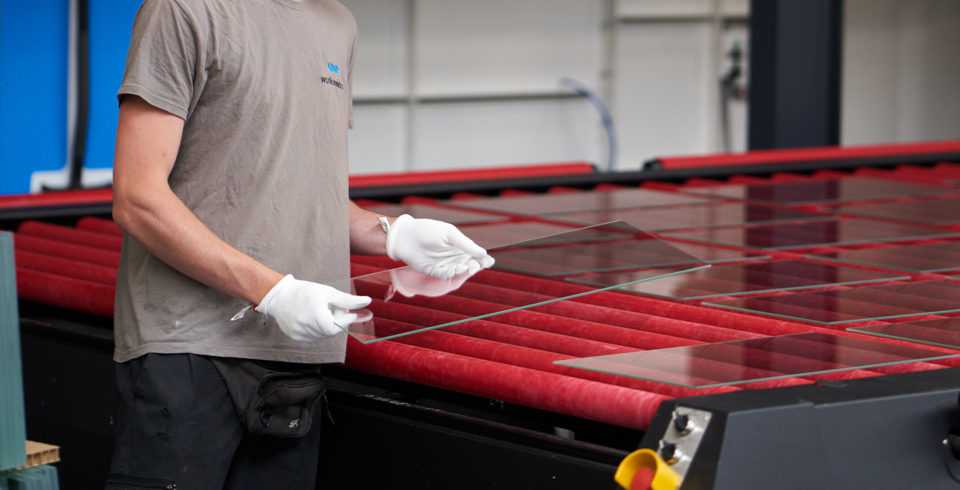Tempering

Tempering
Glass tempering is a deliberate action aiming at creating safety glass. It consists in heating glass to a sufficiently high temperature and then cooling it down quickly. This process makes the material more durable, but its appearance does not change – the glass is still smooth and aesthetic. The end product is marked with the abbreviation ESG (from German Einscheiben Sicherheitsglas).
Properties of tempered glass:
- increased resistance to mechanical stress, i.e. a 5-7 times higher mechanical resistance compared to regular glass,
- increased resistance to thermal stress. It can withstand temperature differences up to about 200°C whereas regular non-tempered glass withstands temperature differences around 30°C.
A characteristic feature of this type of glass is the fact that it cracks into small pieces with unclear edges. This minimizes the risk of serious injury to a person standing nearby.
The functional features of flat glass resulting from tempering have significantly expanded its range of applications. Tempered glass is used primarily in the construction industry, mainly due to safety requirements, as a single double-glazed unit or its component. It is also used in laminated glass and external glazing. This product is also used inside buildings as part of partitions, doors, balustrades, stairs or glass floors. Tempered glass also has aesthetic qualities. Therefore, it can be used as a decorative element by architects, designers or as furniture or household appliances in interior design. Tempered glass can be colorless, colorful, enameled, coated or covered in film. All these variants give glass specific properties.
Tempered glass should meet certain quality requirements. These requirements, as well as the manner of testing tempered glass, are presented in the PN-EN 12150-1 standard: Glass in the construction industry. Thermally tempered sodium lime silicate safety glass. Part 1: Definitions and description.
All manufacturers of tempered glass are obliged to obtain certificates of quality of the glass that they manufacture in accordance with the requirements of the standard above to ensure the comfort of using tempered glass in terms of its safety.
Semi-tempering, in other words, is a process of strengthening glass by heat treatment. Heat strengthening is a process similar to tempering, but with a slower cooling. Cooling with the air stream causes compressive stress, increasing the strength of the glass. Internal stresses generated in this process are relatively smaller than in the case of tempered glass.
The heat-strengthened glass is marked with the abbreviation of TVG (from German TeilvorgeSPanntes Glas).
The heat-strengthened glass, also called semi -tempered glass, has practical application in construction. Like the ESG glass, it has higher resistance against mechanical and thermal loads than the float glass (although lower than ESG glass).
The basic distinctive feature is the characteristic breakage pattern: the glass breaks into larger pieces than tempered glass and the cracks propagate towards edges, which means that the glass shards after destruction block one another and remain in place, and the glass sheet does not fall out of the frame (tempered glass in this case will fall apart into small, blunt pieces). This feature makes TVG glass an interesting alternative to tempered glass, but it is not classified as safety glass (although TVG/VSG laminated semi-tempered glass is considered the safety glass).
Advantages of semi-tempered glass:
- increased flexural strength,
- increased mechanical strength,
- increased heat resistance.
Minimum glass size: 35 x 300 mm
Maximum glass size: 3210 x 7000 mm
Glass thickness: 4 - 19 mm

Production order processing department

Dagmara Gliniecka
Sales Manager dagmara.gliniecka@wutkowski.com.pl
Natalia Kwiatkowska
Sales Specialist (Export) Mob: 453 056 525 natalia.kwiatkowska@wutkowski.com.pl
Magdalena Szmit
Senior Sales Specialist magdalena.szmit@wutkowski.com.pl
Izabela Warczak
Sales Specialist izabela.warczak@wutkowski.com.pl
Maria Karwasz
Senior Sales Specialist maria.karwasz@wutkowski.com.pl
Mateusz Glazer
Sales Specialist mateusz.glazer@wutkowski.com.pl
Adam Laskiewicz
Regional Sales Manager N-W adam.laskiewicz@wutkowski.com.pl
Piotr Nyc
Regional Sales Manager S-E piotr.nyc@wutkowski.com.pl
Zuzanna Welzant
Junior Sales Specialist zuzanna.welzant@wutkowski.com.pl